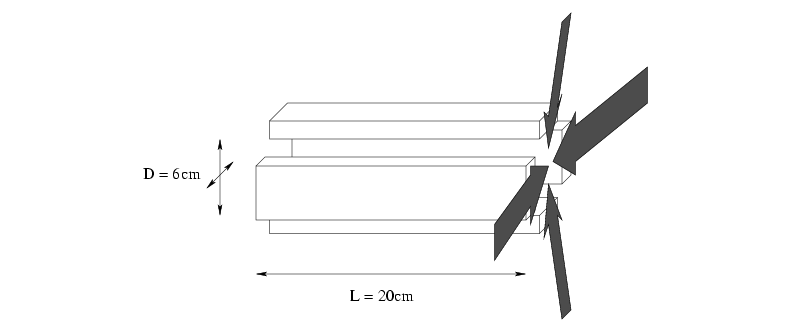 |
The collimator consists of four rectangular mirrors, positioned in two pairs of two mirrors opposite to each other (see fig. 1.3).
In figure 1.4 a one-dimensional collimator is shown. The
two laser beams enter the pair of mirrors under an angle of ![]() with the plane perpendicular to the mirrors at
the back side of the collimator from above and below. Both lasers have the
same angle of incidence
with the plane perpendicular to the mirrors at
the back side of the collimator from above and below. Both lasers have the
same angle of incidence ![]() and
the same frequency, which makes the one-dimensional collimator symmetric in
the plane between the two mirrors.
and
the same frequency, which makes the one-dimensional collimator symmetric in
the plane between the two mirrors.
If an atom moves through the collimator, it will interact with the light
coming both from above and from below. An atom with an upward transverse
velocity component will, due to the Doppler effect, be more resonant with
the laser beam coming from the upper mirror, and will absorb more photons
from this laser beam than from the beam coming from the lower mirror. The
transverse velocity will decrease due to this net momentum transfer. When
the atom is moving parallel to the centerline of the collimator, it
absorbs the same number of photons from the upper and the lower mirror
because the Doppler shift with both lasers is the same (the collimator is
symmetric around the centerline), and both lasers have the same detuning to the red.
The atom will not receive a net momentum transfer in the direction
perpendicular to the center plane of the collimator.
Since the transverse velocity of the atoms in the collimator will become
smaller as the atoms go through the collimator, the atoms
will shift out of resonance due to change in Doppler-shift (Eq.
1.5). To keep the atoms in resonance over the complete
length of the collimator, a small angle between the two mirrors is
introduced, which curves the wave front of the laser light. If the angle
![]() between the two mirrors is chosen well, the change
of the direction of the velocity vector
between the two mirrors is chosen well, the change
of the direction of the velocity vector ![]() is in phase with the
change of the wave vector
is in phase with the
change of the wave vector ![]() , so that
, so that
![]() is
constant. If an atom leaves the source under an angle bigger than
is
constant. If an atom leaves the source under an angle bigger than
![]() , the capture angle, the decrease of the transverse
velocity is not fast enough to keep up with the change of
angle of the laser light, and the atoms will have a nonzero transverse
velocity when they leave the collimator. These atoms will not reach the
channeltron at the end of the setup, and are lost for our experiments.
, the capture angle, the decrease of the transverse
velocity is not fast enough to keep up with the change of
angle of the laser light, and the atoms will have a nonzero transverse
velocity when they leave the collimator. These atoms will not reach the
channeltron at the end of the setup, and are lost for our experiments.